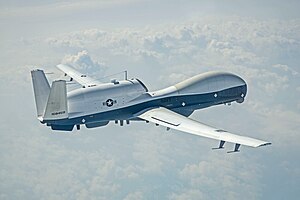
Back نورثروب جرومان إم كيو-4 سي تريتون Arabic Northrop Grumman MQ-4C Triton Czech Northrop Grumman MQ-4C Triton Spanish نورثروپ گرومن امکیو-۴سی تریتون Persian Northrop Grumman MQ-4C Triton French MQ–4C Triton Hungarian MQ-4C (航空機) Japanese 노스럽 그러먼 MQ-4C 트리톤 Korean Northrop Grumman MQ-4C Triton NB Northrop Grumman MQ-4C Triton Polish
| MQ-4C Triton | |
|---|---|
 An MQ-4C conducting a test flight | |
| General information | |
| Type | Maritime unmanned surveillance and reconnaissance aerial vehicle and patrol aircraft |
| National origin | United States |
| Manufacturer | Northrop Grumman |
| Status | Limited service[1] |
| Primary users | United States Navy |
| Number built | US: 68 (planned) + 2 prototypes[2] Australia: 4 ordered (up to 7 planned)[3] |
| History | |
| Introduction date | May 2018[1] |
| First flight | 22 May 2013 |
| Developed from | Northrop Grumman RQ-4 Global Hawk |
The Northrop Grumman MQ-4C Triton is an American high-altitude long endurance unmanned aerial vehicle (UAV) developed for and flown by the United States Navy and Royal Australian Air Force as a surveillance aircraft. Together with its associated ground control station, it is an unmanned aircraft system (UAS). Developed under the Broad Area Maritime Surveillance (BAMS) program, the Triton is intended to provide real-time intelligence, surveillance and reconnaissance missions (ISR) over vast ocean and coastal regions, continuous maritime surveillance, conduct search and rescue missions, and to complement the Boeing P-8 Poseidon maritime patrol aircraft.[4][5][6]
Triton builds on elements of the RQ-4 Global Hawk; changes include reinforcements to the airframe and wing, de-icing systems, and lightning protection systems. These allow the aircraft to descend through cloud layers to gain a closer view of ships and other targets at sea. The sensor suites help track ships by gathering their speed, location, and classification.[7]
The MQ-4C System Development and Demonstration (SDD) aircraft was delivered in 2012 and the MQ-4C was expected to be operational with the US Navy by late 2015[8][9] with a total of 67 aircraft to be procured for the US Navy. Initial Operational Capability (IOC) for the MQ-4C was achieved in 2018[1] with Full Operating Capability (FOC) planned in 2023.[10] Australia has ordered four Tritons, with the first entering service in June 2024.
- ^ "GAO-15-342SP DEFENSE ACQUISITIONS Assessments of Selected Weapon Programs" (PDF). US Government Accountability Office. March 2015. p. 115. Archived (PDF) from the original on 24 September 2015. Retrieved 15 July 2015.
- ^ "Royal Australian Air Force Reactivating Squadron to Operate New MQ-4C Tritons". 3 March 2023.
- ^ Freedberg Jr., Sydney J. (1 October 2014). "Triton, Poseidon, & UCLASS: The Navy's ISR Balancing Act". breakingdefense.com. Breaking Media, Inc. Archived from the original on 4 October 2014. Retrieved 3 October 2014.
- ^ "P-8A Multi-mission Maritime Aircraft (MMA)". U.S. Navy Fact File. United States Navy. Archived from the original on 11 July 2007. Retrieved 29 May 2012.
- ^ MQ-4C Triton: Persistent Maritime Intelligence, Surveillance and Reconnaissance Archived 16 April 2014 at the Wayback Machine
- ^ "Meet Triton, the Navy's New Spy Drone". Popularmechanics.com. 14 June 2012. Archived from the original on 24 August 2012. Retrieved 27 August 2012.
- ^ Pentagon inspector finds no fault with US Navy’s 70-Triton buy Archived 30 September 2015 at the Wayback Machine - Flightglobal.com, 17 September 2015